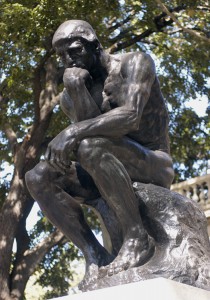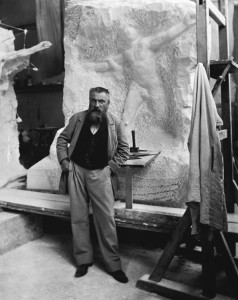Auguste Rodin 100
November 17, 2017
Today, November 17, marks the 100th anniversary of the death of prolific French sculptor Auguste Rodin (1840-1917). Earlier this year, the Grand Palais in Paris, France, celebrated the anniversary with “Rodin: The Centennial Exhibition” from March through July. The Grand Palais (an exhibition hall and museum complex) collaborated with the nearby Rodin Museum to feature numerous masterpieces created by Rodin, largely considered the greatest sculptor of the late 1800’s and early 1900′s. The Rodin exhibit and celebration extended to art museums in Berlin, Chicago, Cleveland, San Francisco, and other world cities.
Rodin created an enormous number of sculptures of the human figure. Many of them have a great deal of emotional intensity, and explore a wide range of human passions. The inner feelings of his figures are expressed through a vigorous sense of movement and by gestures that emphasize different parts of the body. Many of his figures are incomplete or fragmentary. These works consist of just a torso, a head, or hands.

Auguste Rodin’s The Thinker is one of the French sculptor’s most famous works. Several versions of this statue exist. Credit: The Thinker (1880), bronze statue by Auguste Rodin; Musee Rodin, Paris, France (© Timothy McCarthy, Art Resource)
Rodin was primarily a modeler, preferring to work with clay and wax rather than to carve in stone. After he created the original model, his assistants would translate it into marble or bronze. Inspired by the Renaissance sculptor Michelangelo, Rodin’s marble figures are often beautifully smooth and finished, emerging from parts of the marble that are often very rough. The surfaces of his bronze works combine a thorough understanding of anatomy with a rough texture that allows light and shadow to enliven the work.
Rodin was born in Paris on Nov. 12, 1840. He did not win public recognition for many years, and he had to earn his living designing popular sculpture and ornament for commercial firms. Indifference and misunderstanding greeted his first exhibits, but appreciation for his work gradually spread. By 1880, his genius began to be more widely appreciated, and by the 1900′s, he was world famous.
In 1880, Rodin was commissioned by the French government to create a large sculptural door for the Museum of Decorative Art in Paris. The subject was the “Inferno” from Dante’s Divine Comedy. The door was never finished, but Rodin created many figures for it. Later, he developed many of them as independent sculptures. The best known include The Thinker and The Kiss. Rodin’s most important later works include the monumental group The Burghers of Calais and the monument to author Honoré de Balzac.



